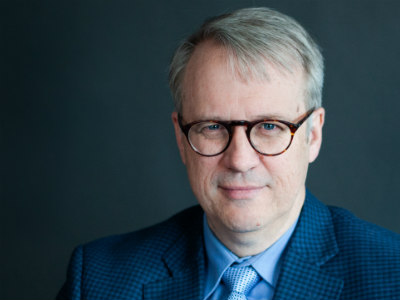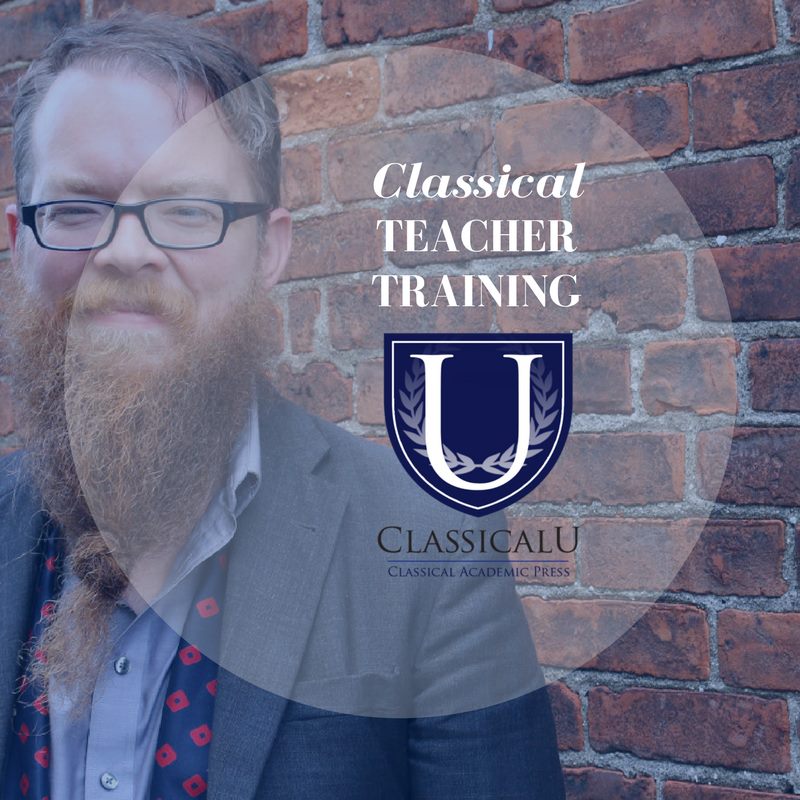by Christopher Perrin, PhD | Sep 29, 2010 | Book Reviews
A review of Desiring the Kingdom: Worship, Worldview, and Cultural Formation, by James K. A. Smith.
By Christopher A. Perrin, PhD
We all have ideals—ideals for a wonderful marriage, the best job, a superb vacation. Our ideals, however, are often fuzzy. What does the ideal church really look like? An ideal government? What about an ideal school?
Well to outline an ideal marriage involving the intersection of two inscrutable human beings is a difficult challenge, to actually live out an ideal marriage is beyond difficult. What might an ideal school look like—with the intersection of two to three hundred human beings—parents, teachers, administrators, board members and….students? And that would be a small school.
If James K. A. Smith is right, we simply cannot help imagining an ideal future, an ideal of human flourishing. According to Smith in his book Desiring the Kingdom: Worship, Worldview and Cultural Formation, imagining ideals is a large part of what it means to be human. We all are seeking some version of the good life, we all desire a kingdom. What is more, we are all being shaped and formed in various ways to love and desire one sort of kingdom or another.
Smith contends that before we humans are cognitive, rational beings we are creatures of desires, passions and loves. He further contends that the way we change is not primarily a matter of the mind, but primarily the result of the heart-shaping forces of the “cultural liturgies” we encounter in the world. He writes, “Because our hearts are oriented primarily by desire, by what we love, and because those desires are shaped and molded by the habit-forming practices in which we participate, it is the rituals and practices of the mall—the liturgies of the mall and market—that shape our imaginations and how we orient ourselves to the world. Embedded in them is a common set of assumptions about the shape of human flourishing, which becomes an implicit telos or goal of our own desires and actions. That is, the visions of the good life embedded in these practices become surreptitiously embedded in us through our participation in the rituals and rhythms of these institutions. “
Smith takes time to examine the ways that various institutions do in fact act as cultural liturgies. He begins with the mall, imagining what it might be like for a Martian anthropologist to study its culture. Smith is convinced that such an anthropologist would see the mall as a thoroughly religious institution. The mall has a daily visitation of pilgrims who enter a large and dazzling cathedral of glass, concrete, light and ornamentation. There are banners and flags in displayed in a large atrium; there are familiar texts and symbols placed on walls to help us easily identify what is inside the various chapels that are contained in this labyrinthine cathedral. Rich iconography lines the wall of each chapel, and there are many three-dimensional statues adorned with the garb that we too can acquire in imitation of these ideals. These same icons, statues and exemplars can be found in similar temples across the country and around the world. In fact the wide distribution of these colors and icons are found in many places in the outside world and have drawn us as pilgrims in the first place. The power of the gospel message of these temple is the power of beauty, “which speaks to our deepest desires and compels us to come not with dire moralisms but rather with a winsome invitation to share in the envisioned good life.”
At this point, Smith is just getting started with his analysis of the “religion of the mall.” He goes on to describe the purchasing experience as a kind of secular Eucharist. Understandably, he does not like or praise the religion of the mall. He does acknowledge, however, that the mall understands something profound about human beings. It embodies its view of its kingdom, rather than merely talking about it. He writes, “Indeed, the genius of mall religion is that actually it operates with a more holistic, affective, embodied anthropology (or theory of the human person) than the Christian church tends to assume. Because worldview-thinking still tends to focus on ideas and beliefs, the formative cultural impact of sites like the mall tends to not show up on our radar.”
As you might guess, the point of Smith’s book is to help us turn on our radar to the formative impact that various cultural liturgies have on us all. Of interest to classical educators will be his liturgical analysis of university education and of Christian college education. Using Tom Wolfe’s book I am Charlotte Simmons, Smith points out that the college experience is far more than the 15 hours a week a student spends in a classroom. Secular university experience exerts a dynamic and intentional shaping influence on college students in dozens of ways. Dorm life, frat house life, football games, drinking, bar and club escapades, hooking up and an exhausting, frenetic rhythm of classes, study, exams shape and form students for the “real world” of “corporate ladder climbing and white-collar overtime needed in order to secure the cottage, the boat, and the private education for the kids.” Smith concludes that while the classroom, laboratory, lecture hall and library have performed some role in shaping a student, it does not compare to these other ways students are shaped. The information provided in the academic areas is “not nearly as potent as the formation we’ve received in the dorm and frat house, or the stadium and dance club.”
His look at Christian colleges is not much more encouraging. Too many Christian colleges in his opinion simply take the basic secular approach to education and add the integration of a Christian worldview or Christian perspective. Smith suggests that the dominant paradigm of Christian education asserts that “goal of a Christian education is to produce professionals who do pretty much the same sorts of things that graduates of Ivy League and state universities do, but who do them ‘from a Christian perspective,’ and perhaps with the goal of transforming and redeeming society.” For Smith this is a regrettable reduction as it “unhooks Christianity from the practices that constitute Christian discipleship.” For Smith, the worship practices of the church must be vitally bound up with the rhythms and practices of a Christian college (and school). When the Christian college is unhooked from the liturgies of the church we end up with an intellectualization of Christianity, leading students to think that “being a Christian doesn’t radically reconfigure our desires and wants, our practices and habits.” This happens because for far too long Christian education has “been concerned with information rather than formation; thus Christian colleges have thought it sufficient to provide a Christian perspective, an intellectual framework, because they see themselves as fostering individual ‘minds in the making.’ Hand in hand with that, such an approach reduces Christianity to a denuded intellectual framework that has diminished bite because such an intellectualized rendition of the faith doesn’t touch our core passions.”
I think by now you sense Smith’s thesis beginning to sink in. Christian worldview instruction is not enough. Appealing to the mind and intellect is not enough. Not that instruction in Christian worldview and ideas should not be done—such instruction is vital. But it is not sufficient, not enough. We must address the core passions of our students, and we do this by means of creating community, atmosphere, rhythms, practices, traditions that shape the hearts of students by engaging them as affective, passionate lovers, not mere minds. The church, rightly worshiping, seeks to do this. Welcoming, greeting, singing, hearing, tasting, standing, kneeling, we worship with all of our person—mind and body. Embodied worship is formative and shapes our love for the kingdom of God and acts a powerful counter-formation over against the formative influence of a dozen secular liturgies we witness and experience. In fact the liturgy of worship helps subvert the power of these secular liturgies, wising us up to their power and methods.
This is where things get interesting. Could it be that our children are being shaped to love a version of the good life that is primarily determined by the “liturgies” of the mall, football stadium, TV sitcoms and the iPod? Could it be that our schools privilege direct engagement with the mind, and the presentation of ideas and a Christian worldview but are nonetheless failing to thwart the power of these other shaping influences? Any teacher with experience can tell you about scores of students whose minds and hearts are seldom truly present in the classroom. They are instead occupied with the shopping for the next fashionable item, the next soccer game, the latest movie, Monday Night Football, the coming rock concert. These things shape them and engage them as lovers, and the teacher often feel powerless standing before her whiteboard with a black marker in her hand. She wonders if would not be better to show then an educational movie—something they can relate to.
Consider the atmosphere and community of your school. What is its liturgy? That is, what are its rhythms, rituals, practices and traditions? We carefully plan our curriculum and lessons. Do we carefully plan and create rhythms, rituals, practices and traditions? Do our teachers carefully plan rhythms, rituals, practices and traditions for each class of students? If Smith is right, then it is these things that will most profoundly shape what our students will love. Every teacher knows that students will forget 75% of the content you “teach” them in a classroom. Might it be wise then to pay attention to more than just content think about form with the same rigor? How can we shape, form and engage hearts, minds and yes, even bodies? Is there vibrant worship in you school? Does music echo through the halls and the great art adorn the walls? Are their dinner parties and great conversation with students and adults alike? Is your facility attractive and conducive to worship and learning? Are poems read and recited, stories written and told? Is Scripture read at lunch for a time? Are there traditions of hospitality when existing students welcome new students into the school, when upper school students warmly welcome new 7th graders or 9th graders? Do teachers and parents gather socially to read books, cook, dine and pray? Do high school students babysit for the young children of teachers (maybe at no charge?). Do you older students help teach the younger students and join them for games on the playground from time to time? Do teachers and students go hiking together or bike-riding or running? Are pastors visiting your school counseling students and speaking in your classrooms or chapel services, or teaching a Bible class? Do you pray for the churches represented by your school and for each pastor by name? Does your school fast occasionally and give money or food to the needy?
These and dozens of other questions might enable us to think more deeply about embodying classical Christian education, such that students absorb it with all five senses and with their hearts as well as their minds. By considering such questions (and generating more) we might clarify our vision of an ideal classical school, and remove much of the fuzziness and confusion that impedes enthusiasm and momentum. Classical education has historically been communal and ecclesial and Smith poignantly reminds us of this. He also helps us to see more clearly that a classical Christian education involves the collaboration of family, church and school as we seek nothing less than the kingdom of God. Classical educators and leaders would do well to learn from the insights of this valuable and timely book.

by Christopher Perrin, PhD | Jul 9, 2015 | Articles
The Christian tradition speaks regularly about the importance of ordering one’s affections or desires. Augustine, for example, speaks about an ordo amoris (an order of love) in The City of God. Ignatius speaks of “disordered affections” that cloud our judgment. C. S....
by Christopher Perrin, PhD | Mar 11, 2014 | Articles
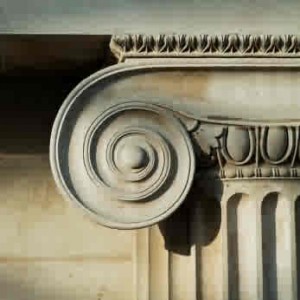
From time to time I am asked what colleges I think make for a good fit for classically-educated students. With my second child in college and my first already graduated, naturally I have thought about this a bit. In my work with the Society for Classical Learning, I have also been working with my colleagues to partner with colleges around the nation.
The truth is that classically-educated high school graduates are going to a wide variety of colleges, both Christian and secular. In my experience, these students are competitive and often gain entry into selective colleges, and often receive scholarships. The word is out among many colleges that classical students are generally great students, well-prepared for high-level college work. I know from talking to professors firsthand how this seems to have worked: about ten years ago various colleges began to notice that classically-educated students were excelling at college. K-12 schools (and homeschools) from which these students came where identified as small but rich sources of great students. The colleges then began to recruit directly at many of these schools. Happy students at college began to encourage their friends (still in high school) to apply. More classical students began to flow into some of these colleges (like Grove City College here in PA).
Some of these colleges began to create programs especially for classically-educated students (like Hillsdale College and Grove City College). Some colleges began to emphasize programs already established that appeal to classical students (like the Torrey Institute at Biola College, Great Texts Program at Baylor University and the Jerusalem & Athens Forum at Gordon College). Some colleges have started graduate programs designed to equip students to teach at classical schools like New Saint Andrews College and Houston Baptist University.
Then there are those colleges that have traditionally already had aim at classical students (some new some older): The University of Dallas (Catholic), St. Johns College (secular), Thomas Aquinas College (Catholic), Patrick Henry College (Christian), New Saint Andrews College (Christian). Traditionally academic Christian colleges like Wheaton College and Calvin College have also begun taking notice of classical students, and attracted them. Calvin philosophy professor James K. A. Smith (author of Desiring the Kingdom) has been influential to leaders in the classical Christian education renewal, and become an advocate for it. The Wheaton College graduate school dean (and professor of New Testament) Nicholas Perrin is also an advocate of the renewal and indeed helped found a classical school close to Wheaton (Covenant Classical School).
Other Christian colleges are also taking note of classical students. Messiah College and Eastern College have attracted classical students, and professors in both colleges have expressed interest in recruiting more. The same could be said for many other Christian colleges such as Covenant College, Geneva College, LeTourneau University, The Kings College and Belmont College, and several others.
Classical students are also going to secular colleges, most often the smaller liberal arts colleges, but also larger state universities and then often in honors programs. Yes, there are some classical students who have gone to Harvard, Princeton, Penn, Stanford, MIT and the like, but these schools are statistically extremely hard to get into, even by those qualified (a perfect SAT score doesn’t mean you will gain admission). Students are also going to established liberal arts colleges such as Middlebury College, Grinnell College, Furman University and Davidson College. Regionally it is not uncommon for classical students to gain admission to the larger state universities such as the University of Virginia, Penn State or the University of Michigan.
All in all, classical students are getting into very good colleges, and are sought-after by colleges that recognize the excellent education they have received.
So what do I recommend? I think that the college should fit the student and the student should fit the college. Some students are ready for the experience of a secular college, others are not. Some will thrive at a larger state university, but many classical students will want the smaller classes and discussion format more frequently offered at small liberal arts colleges, Christian or secular. Classical students going to a large university will likely enjoy honors programs or finding more dynamic interaction among students and professors in their major. Christian classical students will want to find fellowship in a Christian group. There is wisdom in the notion that students must seek out the education they want at any college and not expect it will just come to them. We should also note that factors such as proximity and cost are important factors when selecting a college.
Still, I have a list of favorites, based on my limited experience and knowledge. This list is therefore short and no doubt leaves out many excellent colleges. Feel free to post your own favorites and list the reasons–I may then revise my list based on your feedback! For a larger list of colleges that classical students are attending, see the list provided by the Association of Classical Christian Schools (ACCS) here: List of colleges ACCS students attend
Christian Colleges
- Grove City College: Very friendly to classical students, and actively recruiting them. GCC has developed a classical studies minor that deepens classical learning and prepares students to teach in classical schools. Disclaimer: my daughter Zoe graduated from GCC.
- Biola University: The Torrey Institute at Biola has been a great fit for many classical students and has sent many graduates into classical schools as teachers.
- New Saint Andrews College: A small, dynamic and classical college in Moscow, Idaho. Their oral Latin program is notable and unusual. One “major” for all students.
- Baylor University: The Great Texts Program has done the same thing for classical students as has the Torrey Institute at Biola.
- Patrick Henry College: A small college in Northern Virgina (very beautiful setting) that is classical in orientation, and offers remarkable internships in Washington, D.C.
- Gordon College: The Jerusalem & Athens Forum is excellent, so is the Gordon in Orvieto Program.
- Houston Baptist University: This college is rapidly growing to serve classical students and has been recruiting great professors to the campus (e.g. Louis Markos, John Mark Reynolds).
- Wheaton College: Traditionally known for great academics, well-suited for classical students.
- Calvin College: Very much like Wheaton, with a growing appreciation for classical students.
- Messiah College: A warm, communal atmosphere with dedicated professors who love teaching. The philosophy and English departments are particularly welcoming and strong.
- Eastern College: Another warm campus (blue jeans atmosphere). The honors program has attracted classical students.
- Covenant College: A strong academic college in the reformed tradition.
- University of Dallas: A robust Catholic college that with a strong humanities emphasis.
- Ave Maria College: Located in Florida, this is a relatively new Catholic college that is traditional, pious and classical.
Secular Colleges
- Hillsdale College: A conservative liberal arts college in Michigan, friendly to the Judeo-Christian tradition in the U.S. It also features a program for training classical educators.
- St. Johns College: The third oldest college in the country, this is a “great books” school with a common curriculum and small classes. There is a campus in Annapolis, MD and Santa Fe, NM.
- University of Virginia: Strong classical department; many classical students have gained admission to UVA.
- University of Texas: I believe UT hosts the larges classics department in the world. A fine choice for students wanting to pursue a classics major.
- Furman University: Many classical students enjoy this school and recommend it to others.
by Christopher Perrin, PhD | Aug 5, 2011 | Articles, Book Reviews
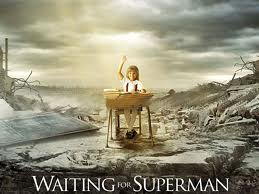
Waiting for Superman (Paramount Pictures)
Christopher A. Perrin
It is hard to watch David Guggenheim’s documentary Waiting for Superman without leaning into the screen with anticipation and hope, only to droop with disappointment, yes even despair. It is the kids that do that to you—real children with real dreams, bright and earnest, brimming with surprising potential, supportive parents or grandparents, hoping and praying they can be one of the few selected (by lottery) to attend a promising charter school. They don’t get in (with two exceptions).
Daisy is a Hispanic elementary student from a challenging section of Los Angeles (East LA). The camera follows her for most of a year, recording her at school and home diligently studying, talking excitedly about her dreams to be come a veterinarian. After watching her for a few months, you have no doubt she could become veterinarian (or just about anything else.). Her extended family pulses with her potential, believes in her, as you do. If she stays in her public school system, her chances of going to college are virtually nil. A local charter school offers hope—the camera reveals the charter school is doing excellent work and could keep her on her dream’s path. After getting to know Daisy and her family, you watch her sitting in the public lottery, fingers crossed, with hundreds of other students all vying and praying for one of the few spots at the school. She doesn’t get in. She will have to attend her local middle school, which has a 40% graduation rate (from eighth grade). And so it goes with several other hopeful students followed by Guggenheim’s camera.

The film gives the impression that Guggenheim is no natural critic of public, government education and that perhaps he would have liked to put his own children in a public school in Los Angeles. Diane Ravitch (in her critical review of the film: http://www.nybooks.com/articles/archives/2010/nov/11/myth-charter-schools/?page=1) points out that Guggenheim himself attended Sidwell Friends, an elite preparatory school in Washington, D.C. (Obama’s children attend Sidwell). Whatever his predispositions toward public education, when his children became of school age he simply could not seriously consider enrolling his children in the local public school. For him, the raw data was persuasive: too many students were getting lost in the school system, unable to realize their academic potential, far too few even graduating from high school (in some cases below 20%). What was going wrong inside these schools? He set out to find out and produced Waiting for Superman (he also produced An Inconvenient Truth, about global warming) and enrolled his children in a private school—because he could afford to.
What goes wrong in these schools is nothing new to anyone even generally familiar with urban, public education. Bad teachers can’t easily be removed. Even with significant funding, good books and supplies are scarce (and often poorly treated or destroyed by students). Students disrespect teachers and teachers endure students. Resolute administrators become disillusioned and give up, or become opposed (by powerful teacher unions) and forced out. Schools lack a culture of study, rigor, discipline or optimism and instead become soul-squelching institutions dominated by popular youth culture and the culture of the street. All this is nothing new. What is new is what the eye of the camera reveals. We don’t just hear it, we see it, and we see the Daisys of the world being lost.
We also see some remarkable people working for change. Michelle Rhee (former superintendent of Washington, D.C. schools tell us of her experience trying to reform one of the worst-performing school districts in the nation. She worked valiantly, was opposed venomously, then removed when a new mayor was elected (campaigning that he would remove her if elected). Rhee concludes that the biggest obstacles to reforming the D.C. district is not money or curriculum but the teachers themselves (not all, perhaps not most, but enough) who are more concerned with their job security (tenure) than students and their welfare.
Another administrator with Kipp charter schools (http://www.kippny.org/) is doing noble work providing a superb education to minority students in Harlem. Kipp seems to prove that poverty does not keep students from an excellent education—bad schools do. The Kipp charter school in Harlem has a 96% graduation rate. Guggenheim notes that he used to believe that bad (poor) neighborhoods made for bad schools. Now he believes bad schools cause bad neighborhoods.
Who is waiting for Superman? The children are, and it appears he is not coming. These students need rescue—rescue from their failing, dis-affecting, de-humanizing schools. If there are any heroes in the film it is the courageous administrators and teachers of several charter schools that have been started and succeeded (almost against all odds) right amidst a ring of failing schools. Clearly, Guggenheim thinks we must offer students like Daisy something different and better, like innovative charter schools. After watching the film it is hard to disagree.
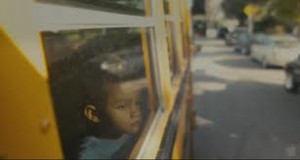
However, even great charter schools lack something vital—the freedom to engage the culture of the Christian west and her queen, theology. We must settle for a secular rigor and an eclectic and unstable curriculum. Put another way, we must settle for getting urban kids to suburban standards. Still secular, still likely encumbered with all the challenges of our better suburban public schools, but still better.
As well, we must ask ourselves if Guggenheim is telling all the critical parts of the story. He admits that only one in five (20%) charter schools are succeeding. He does not show any examples of successful public schools in urban settings. He chooses not to tell us the remarkable amount of money that is spent at some of these charter schools (in his film) that receive public and private funding. The organization that runs the Kipp schools, for example, has over $200 million in assets and provides students with an extensive array of social and medical services. The boarding school featured in Washington, D.C., spends $35,000 per year on each student. In other words, the charter schools that Guggenheim features are funded well beyond typical public (and private!) schools. With this kind of funding, can we really regard such students as impoverished? Diane Ravitch (a prominent historian of education) points to studies that show that only 17% of charter schools are out-performing comparable public schools, that 37% are performing worse than public schools and that 46% are performing the same as public schools.
Ravitch thinks that Guggenheim is engaging in artistic propaganda and special pleading, even while highlighting urgent problems and some remarkable successes. For Ravitch, poverty is a chief causal factor contributing to student performance and thus school achievement. What she doesn’t make explicit (but seems to assume) is that urban families are in crisis and in fact disappearing as in-tact supportive communities. Without a supportive family, a student can rarely succeed in a public, charter, private or classical Christian school. Now there is a relationship between poverty and family cohesiveness, but being poor (as hard as that is) does not cause the disintegration of a family. Poverty is not, per se, a sin nor does it cause sin, though it brings its peculiar temptations even as wealth does.
Something beyond mere poverty is at play, destroying American families, not only in the cities but in the suburbs. Urban families, however, are clearly in greater crisis and no doubt poverty is exacerbating the family breakdown. Leaving aside, for the moment, the complex nexus of factors making war on the American family, we should remember that schools can teach but not single-handedly resuscitate a family dying from a hundred wounds. Not even great classical Christian schools. Schools cannot effectively serves as social welfare agencies, health care providers, churches, or surrogate mothers and fathers. As Jacques Barzun pointed out long ago (in Teacher in America), schools can teach but not educate, for to “educate” requires a congenial collaboration among parents, families, friends, supporters, churches, teachers, administrators and students. Ravitch notes that all the families in Waiting for Superman are supportive and invested in the education of their children (special pleading again). The reality is that far too many families are broken and unable to support and encourage their children generally, much less follow and support their education. Guggenhiem seems to think that a local charter schools can change all this. He thinks, in fact, that it is failing schools that make for failing neighborhoods—as if the local school has done the most to cause the breakdown of urban culture and families.

Causation (as philosophers and scientists will tell us) is tricky and hard to pin down. Our urban culture is suffering on account of multiple causes in my view, not the least of which is the ubiquitous, invasive influence of secular mass media that is shaping the souls of our American youth in and out of the cities. James K. A. Smith has pointed out the various ways “secular liturgies” from the mall to the athletic field to the movies to Facebook are powerfully forming our youth to love a secular ideal of human flourishing much different that the New Testament ideal of the Kingdom of God (Desiring the Kingdom: Worship, Worldview and Cultural Formation). Which leads me to say that without the revival of city churches urban schools (of any stripe) will have a greatly diminished impact. A great urban school cannot do all that is needed. In fact an urban school can only become great when urban churches support it and compliment it with their own vibrant ministries to families. Christian educators cannot flee to schools as the best means of reviving our urban youth and families. Rather churches, schools and families must form vital partnerships if there is any hope of creating culture and cultivating students not just as future workers but human souls.
Private Christian educators should take note of Guggenheim’s film, but view it critically. He does engage in special pleading, generalizing and one two many straw men. He does not assess the vital role of supportive families or churches in providing education and supporting local schools. His use of statistics has been questioned (effectively by Ravitch). He does, however, powerfully portray the sad state of many urban public schools and the plight of many urban youth, who at present have no choice but to attend a school that will fail them as it has others. By providing a few shining examples of remarkably successful charter schools (even if very well-funded), he suggests it could happen again and elsewhere.
Christians should not wait for public funding or a public charter to offer hope to Daisy and thousands like her. While it will take immense sacrifice of time and resources, it is now time for the accrued wisdom and experience of the last 30 years of renewing classical and Christian education to be brought to bear to start schools in all the major cities in the U.S. This is already beginning to happen, but needs to extend and expand. The Oaks Academy (http://www.theoaksacademy.org/) in Indianapolis, IN is providing a superb liberal arts education to students in that city. Logos Academy of York, PA (http://www.logosyork.org/) is doing the same there. Mortimer Adler quipped that best education for some (meaning a robust liberal arts education) is the best for all. Some of us have been able to afford to give a recuperated, if imperfect classical education to our own children. Are we now ready to give it to others who otherwise will never receive it? They are wanting and waiting
by Christopher Perrin, PhD | Mar 15, 2011 | Audio, Book Reviews, Interviews & Podcasts

Many readers of this blog may recall my review of the book Desiring the Kingdom: Worship, Worldview and Cultural Formation by James K. A. Smith who is also an associate professor of philosophy at Calvin College. I like the book immensely, and think that Smith has articulated better than anyone else in modern times how humans are shaped and–if you will–what humans are for. According to Smith, humans beings cannot help imagining an ideal of human flourishing and in fact, imagining ideals is a large part of what it means to be human. Smith contends that we are all seeking some version of the good life, we all desire a kingdom. What is more, we are all being shaped and formed in various ways to love and desire one sort of kingdom or another.
Now all this has profound implication for education, for whatever else education is, it is a sustained attempt to shape and form a human being. Even when educators have no idea what ideal or form they hold forth–they are shaping and forming nonetheless, for education occurs directly and indirectly, for better or for worse.
Several leaders in the renewal of classical Christian education noted this book when it was published in 2009, and immediately saw its relevance to the renewal. Among those leaders was Bob Ingram, headmaster at the Geneva School of Orlando. After reading the book on a plane flight, Ingram decided he had to have Smith come visit his school and address his faculty. When I heard that Smith was coming to Geneva, my colleagues and I at Classical Academic Press offered to fly down to Orlando and record Smith. We did that in October (2010) and can now post the results of that fruitful interview here on this blog. While we recorded him on video and audio, the audio clips are listed below–we will release the video clips later this spring. Many thanks to Bob Ingram of the Geneva School and to Geneva educators Ravi Jain, Kevin Clark and Grant Brodrecht who with Bob conducted the interview with Jamie Smith.
The entire 45 minute interview can be heard by clicking on the link entitled “Jamie Smith Interview on Classical Education.” Alternatively, you can listen to any individual segment from the interview by clicking on the other links listed below. These individual clips average about 5 minutes in length. Enjoy.
James KA Smith Interview on Classical Education (entire interview-45 min)
James KA Smith Pedagogy Assumes an Anthropology
James KA Smith How Humans are Shaped
James KA Smith The Problem with Worldview Education
James KA Smith Secular Liturgies
James KA Smith Countering Secular Liturgies
James KA Smith How Christian Schools Are Secular
James KA Smith The Church and Christian Education
James KA Smith Pastors and Classical Christian Education
James KA Smith What Secular Education Lacks
James KA Smith Humans as Thinkers Believers and Lovers
James KA Smith Postmodernism and Classical Christian Ed
James KA Smith Neuroscience and Character Formation
James KA Smith Education, Culture and The Arts
James KA Smith Advice for School Administrators








